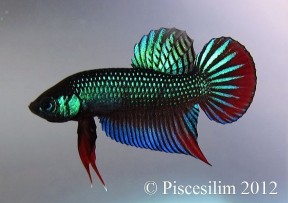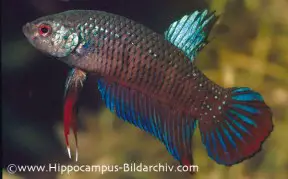Betta imbellis
Crescent Betta
Etymology
Betta: from ikan betah, the vernacular Malay for species of this genus.
imbellis: from the Latin imbellis, meaning ‘peaceful’.
Classification
Order: Perciformes Family: Osphronemidae
Distribution
Thought to occur naturally in southern (peninsular) Thailand, Peninsular Malaysia, and northern Sumatra, but has been introduced to other areas with feral populations now established in Singapore, for example.
Type locality is ‘wetlands in the area surrounding Kuala Lumpur, Malaysia’.
Habitat
Inhabits still and sluggish waters, including rice paddies, swamps, roadside ditches, streams and ponds. These are often shaded by submerged, surface or marginal vegetation and sometimes contain little dissolved oxygen. Water conditions tend to vary and change rapidly during the annual monsoon season. Substrates can vary from leaf litter to mud, sand, or deep sediment. While most populations occur in freshwater some are found in brackish coastal swamps.
Introduction of ornamental forms and other Betta spp. such as B. splendens is known to be having an adverse effect on the genetic integrity of some wild populations.
Maximum Standard Length
50 – 60 mm.
Aquarium SizeTop ↑
An aquarium with base measurements of 45 ∗ 30 cm or equivalent is large enough for a pair.
Maintenance
This species fares best in a well-planted, shady aquarium with plenty of surface cover in the form of tall stem plants, floating types such as Salvinia or Riccia spp., or tropical lilies from the genus Nymphaea. Cryptocoryne spp. are also a good choice.
Driftwood can also be used and other plants such as Microsorum or Taxiphyllum spp. may be attached to it. Small clay plant pots, lengths of plastic piping or empty camera film cases can also be included to provide further shelter.
The addition of dried leaf litter offers additional cover and brings with it the growth of microbe colonies as decomposition occurs. These can provide a valuable secondary food source for fry, while tannins and other chemicals released by the decaying leaves are considered beneficial.
As it naturally inhabits sluggish environments strong water movement should be avoided, with an air-powered sponge filter set to turn over gently adequate. Keep the aquarium well-covered and do not fill it to the top since like all Betta spp. it requires occasional access to the layer of humid air that will form above the water surface, and is an excellent jumper.
Water Conditions
Temperature: 20 – 28 °C
pH: 5.0 – 7.5
Hardness: 18 – 179 ppm
Diet
Likely to prey on aquatic and terrestrial invertebrates in nature.
Captive fish will normally accept dried products once they are recognised as edible, but should be offered plenty of small live or frozen foods such as Daphnia, Artemia or chironomid larvae (bloodworm) regularly to ensure development of optimal colour and condition.
Take care not to overfeed as Betta spp. seem particularly prone to obesity.
Behaviour and CompatibilityTop ↑
Not recommended for the standard community aquarium. Its care requirements and disposition mean it is best kept alone or with very peaceful species. Some small cyprinids and loaches that inhabit similar environments in nature are suitable, but proper research prior to purchase is essential and in most cases it is best maintained alone.
Provided there is sufficient cover it is possible to keep more than one male per tank, though it is considered best practice to isolate pairs for breeding purposes.
Sexual Dimorphism
Males are more colourful than females and develop extended fins as they mature.
Reproduction
Bubble nester. It is particularly important to provide plenty of cover for the female, and empty camera film canisters or lengths of plastic tubing can be used to offer potential nesting sites. Floating plants may be incorporated into the nest if present.
The aquarium should have the tightest-fitting cover possible (some breeders use clingfilm/plastic wrap) because the fry need access to a layer of warm, humid air without which development of the labyrinth organ can be impaired.
The pair need not be separated prior to spawning. The male might construct the nest in a tube or canister, under a broad plant leaf or among fine-leaved surface vegetation, and will not usually tolerate the female in the vicinity until it is complete.
The nuptial female becomes paler in colour and dark bars appear on the flanks. Spawning normally occurs beneath the nest in an ’embrace’ typical of osphronemids, with the male wrapped around the female.
At the point of climax milt and a few eggs are released, which the female proceeds to catch between pelvic fins and body. The male then transfers these to the nest while the female recovers any loose eggs. The process is then repeated until the female is spent.
Post-spawning the adults can normally be left in situ although the female is no longer actively involved, the male assuming sole responsibility for guarding and tending the nest.
The eggs hatch in 24-48 hours, remaining in the nest for a further 3-4 days until the yolk sac is fully-absorbed, the male continuing to collect and return any that fall. If threatened the entire nest may be moved elsewhere. Once the fry begin to swim freely the male will lose interest, but the adults do not usually eat their offspring.
The require an infusoria-grade food for the first few days, after which they can accept motile foods such as microworm and Artemia nauplii, though it should be noted that there exist reports of young Betta developing health issues if fed excessive amounts of the latter. Water changes should be small and regular rather than large and intermittent.
NotesTop ↑
This species has been extensively line-bred for aggression in southern Thailand, where it is used in organised bouts in the same way as B. splendens elsewhere. It has also been selectively-bred for the ornamental trade, and hybridised with the congeners B. smaragdina, B. mahachaiensis, and B. splendens, leading to the development of a number of colour forms that do not occur naturally.
Populations from different localities tend to exhibit differences in colouration and patterning, and if the locality of wild fish is known, they are often labelled as such by aquarists in order to maintain accuracy and preserve pure bloodlines, e.g., Penang Island, Tiak/Perak, Batang Berjuntai/Selangor, Sepang/Selangor, etc.
B. imbellis is included in the Betta splendens complex of closely-related species within the genus, of which members share the following set of characters: head length short 22-31 % SL; often a brightly-coloured body; iris of the eye with iridescent green or blue patches; body elongate or slender; opercles parallel when head viewed dorsally; caudal-fin rays red or brown and contrasting with the iridescent interradial membranes; unpaired fins without an iridescent margin; opercle with red or blue vertical bars in males; dorsal-fin rays 0-II, 7-9; anal-fin rays II-V, 21-26.
The unique combination of characters distinguishing B. imbellis from others in the group is as follows: base body colour dark brown to black; opercle with iridescent blue scales; fins iridescent blue; no transverse bars in caudal-fin; caudal-fin with red, crescent-shaped distal band; posterior anal-fin rays coloured red distally.
The genus Betta is the most speciose within the family Osphronemidae. Members have successfully adapted to inhabit a variety of ecological niches from stagnant ditches to flowing hill streams including some extreme environments such as highly acidic peat swamp forests.
The referral of members to a number of groups containing closely-related species is largely based on morphological and behavioural characters. A full list of the species groups as currently recognised can be found here.
Like others in the suborder Anabantoidei this species possesses an accessory breathing organ known as the labyrinth, which permits the fish to breathe atmospheric air to a certain extent. Comprising paired suprabranchial organs formed via expansion of the epibranchial (upper) section of the first gill arch and housed in a chamber above the gills, it contains many highly-vascularised, folded flaps of skin which function as a large respiratory surface. Its structure varies in complexity between species, tending to be more developed in those inhabiting harsher environments.
References
- Ladiges, W., 1975 - Aquarien und Terrarien-Zeitschrift (8): 262-264
Betta imbellis nov. spec., der Friedliche Kampffisch. - Kottelat, M., 2013 - Raffles Bulletin of Zoology Supplement 27: 1-663
The fishes of the inland waters of southeast Asia: a catalogue and core bibiography of the fishes known to occur in freshwaters, mangroves and estuaries. - Kowasupat, C., B. Panijpan, P. Ruenwongsa and N. Sriwattanarothai, 2012 - Zootaxa 3522: 49-60
Betta mahachaiensis, a new species of bubble-nesting fighting fish (Teleostei: Osphronemidae) from Samut Sakhon Province, Thailand. - Kowasupat, C., B. Panijpan, P. Ruenwongsa and T. Jeenthong , 2012 - Vertebrate Zoology 62(3): 387-397
Betta siamorientalis, a new species of bubble-nest building fighting fish (Teleostei: Osphronemidae) from eastern Thailand. - Tan, H. H. and P. K. L. Ng, 2005 - Raffles Bulletin of Zoology Supplement 13: 43-99
The fighting fishes (Teleostei: Osphronemidae: Genus Betta) of Singapore, Malaysia and Brunei. - Tan, H. H. and P. K. L. Ng, 2005 - Raffles Bulletin of Zoology Supplement 13: 115-138
The labyrinth fishes (Teleostei: Anabantoidei, Channoidei) of Sumatra, Indonesia.









September 9th, 2015 at 6:16 pm
The first picture is really an Imbellis?? Looks more like a machaiensis
September 10th, 2015 at 11:43 am
It was collected from a wild population in Penang, Malaysia, so should be B. imbellis.
September 14th, 2015 at 4:15 am
Beautiful! Mine look quite different though!
February 26th, 2019 at 2:24 pm
what is tha plant from the water ?
February 26th, 2019 at 2:25 pm
can i mix him with vampire crabs ?